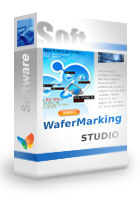Wafer Marking Studio
Keywords: Semi M12, Semi M13, Semi T7 Data Matrix, Semi T1 BC-412
The semiconductor industry is a fascinating and critical part of the modern technology landscape.
What Are Semiconductors?
Semiconductors are materials that have electrical conductivity between conductors (like metals) and insulators (like ceramics). They are the foundation of modern electronics, including computers, smartphones, and other digital devices.
What Are Silicon Wafers?
Silicon wafers are thin slices of highly pure crystalline silicon used as the base material for semiconductor devices. They serve as the substrate for integrated circuits (ICs) and other microelectronic devices.
Silicon Wafers Production Process
Czochralski Method: Silicon wafers are typically produced using the Czochralski method. This involves pulling a single crystal silicon ingot from a molten silicon bath2. The ingot is then sliced into thin wafers.
Wafer Preparation: The wafers undergo several processes to remove impurities and defects. This includes chemical etching, polishing, and cleaning to ensure a smooth and defect-free surface3.
Doping: Impurities are introduced into the silicon wafer to modify its electrical properties. This process, known as doping, allows the creation of n-type or p-type semiconductors1.
Applications
Silicon wafers are used in a wide range of applications, including:
Integrated Circuits (ICs): The primary use of silicon wafers is in the production of ICs, which are found in almost all electronic devices.
Solar Cells: Silicon wafers are also used in the manufacturing of solar cells for renewable energy applications.
Sensors and MEMS: Silicon wafers are used to create sensors and microelectromechanical systems (MEMS) for various applications.
Back Surface Markings of Semi Font, Semi T7 Data Matrix Code, BC-412 Code on Silicon Wafers
Importance of Back Surface Markings
Back surface markings on silicon wafers are crucial for several purposes, including identification, traceability, and quality control. These markings ensure that each wafer can be accurately tracked throughout the manufacturing process.
Types of Markings
Etched Marks: Created using laser ablation, etched marks are typically 12 to 25 microns deep. Known as "hard marks," these permanent markings ensure long-lasting identification.
Annealed Marks: Formed by heating the silicon surface to a specific temperature, annealed marks cause slight deformations that result in visible markings.
Purpose of Back Surface Markings
Identification: Include serial numbers of SEMI Font, Semi T7 Data Matrix barcodes, and BC-412 code to facilitate wafer tracking during production.
Traceability: Essential for tracing wafer origins, aiding in quality control and troubleshooting.
Quality Control: Useful for identifying and segregating defective wafers or marking areas for inspection.
Industry Standards
SEMI T7: Governs back surface marking of double-side polished wafers using a two-dimensional data matrix code.
SEMI M12 and SEMI M13 0998: Standards for alphanumeric marking of silicon wafers.
SEMI T1: Governs back surface BC-412 code marking of silicon wafers.
Wafer Marking Studio
Wafer Marking Studio is designed in accordance with these standards. It enables users to inscribe SEMI font, SEMI T7 symbols, and BC412 symbols on the reverse side of silicon wafers using laser scribers.Features an Capabilities
Our software allows users to insert SEMI font objects, including both single density and double density SEMI fonts. Checksum characters are automatically appended for the user.
User can also insert SEMI T7 Data Matrix objects. The two-character vendor code must match one of the vendors listed in the SEMI AUX1 document's List of Vendor Identification Codes. The tiny cells of a SEMI T7 Data Matrix code can be either squares or small circles.
Additionally, users can insert BC-412 codes into their marking drawings. The barcode part of a BC-412 can be represented either in bars or small circles.
These elements can be effortlessly dragged or rotated on the computer monitor using a mouse.
Users can also easily modify the properties of these objects, such as text and density, to suit their specific needs.
Once the design is complete, users have the option to export their marking drawings to a GCode file or directly inscribe them using a USB-connected laser scriber.
Design and Layout:
Wafer Marking Studio boasts an aesthetic and intuitive user interface, making it easy to work with Semi font, Semi T7 Data Matrix, and BC-412 code.Performance and Efficiency
Wafer Marking Studio features speedy loading times and is highly responsive to user inputs. It is reliable and logs any crashes or errors for continuous improvement.
Support and Documentation
User Guides: Comprehensive documentation, tutorials, and how-to guides are available to assist users.Customer Support: Our dedicated customer support team is accessible via email and phone, ensuring prompt assistance.

